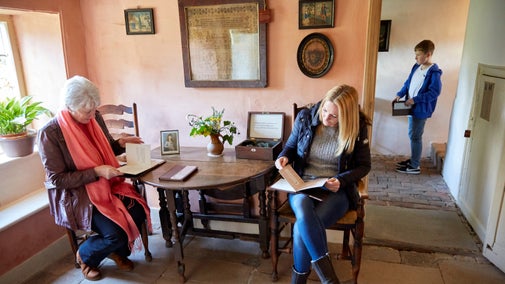
People in history
Discover some of the social history behind the places we care for and uncover fascinating facts about the people who have lived in them.

Women have long been owners and creators of some of the most famous gardens in the UK. Discover more about the gardening pioneers from the past 170 years and the celebrated gardens that carry their legacies, from the romantic planting of Vita Sackville West to the Celtic symbolism of Edith, Lady Londonderry.
Until the early 20th century it was virtually impossible for any woman, regardless of her social background, to enter the world of professional horticulture and garden design. However, the following women broke with convention and created beautiful gardens that are still being enjoyed today.
Jekyll’s drifts of herbaceous planting faded from cool colours to hot and back again. This was in stark contrast to the prevailing fashion for formal bedding schemes. Her partnership with the young architect, Edwin Lutyens, lasted nearly 25 years and their collaboration produced over 100 houses and gardens at the pinnacle of Edwardian garden design.
Jekyll authored ten books in as many years, alongside thousands of articles. Her style of gardening remains popular even today.
Bodnant’s acclaimed gardens owe much to Laura McLaren, Lady Aberconwy, who inherited the house and garden from her father, Henry Ponchin, in 1895. She followed in the footsteps of her mother as a leading Liberal suffragist, but her other passion was horticulture.
Alongside her eldest son Henry, Laura expanded and developed the garden. Her influence can be seen in the ambitious Italianate terraces they planned in the early years of the 20th century. In later life, in recognition of her horticultural achievements, she was awarded the prestigious RHS Victoria Medal of Honour.

Norah Lindsay was the preeminent society garden designer of the interwar years, yet she may have been remembered foremost as a socialite, had her marriage not collapsed in 1924. Aged 51 and needing an income, she used her talent to make beautiful gardens for the titled and wealthy across Britain and Europe.
Without horticultural training but with a great eye for design and colour, Norah borrowed Jekyll’s style, often adding more exuberant and looser planting alongside formal hedging and topiary. You can see Lindsay's work at Cliveden, Blickling Hall, Chirk Castle, Hidcote and Mottisfont Abbey.
Visionary garden designer, suffragette and society hostess, Edith Vane-Tempest-Stewart, Lady Londonderry, created one of the most original gardens of the 20th century at Mount Stewart in County Down, Northern Ireland.
After the First World War and in her 40s, Edith channelled her energies into the garden, filling it with rich symbolism inspired by her Celtic upbringing and Greek myths. She amassed an unrivalled collection of rare and tender plants, taking advantage of the mild climate of Strangford Lough and experimenting with bold planting schemes.
Sissinghurst Castle Garden in Kent is one of the most famous and influential gardens in the world. Purchased in 1930, Vita Sackville-West and her husband Harold Nicolson restored the collection of neglected Tudor buildings and farmland. First and foremost a writer and poet, Vita was not a professional gardener, but her planting and originality are a hallmark of the garden.
She filled the formal structure of garden rooms and vistas with romantic, billowing planting. Vita also defined colour schemes including the White Garden, which has inspired thousands of imitations.

Kitty Lloyd Jones had neither the social connections nor financial security of the women gardeners before her. One of the first women to train as a professional horticulturalist, she graduated from Reading University in 1925.
Despite her exceptional ability, she struggled to find work in her chosen profession. A chance job led to Kitty’s first commission and an important entrée into the world of the wealthy. Her style of gardening wasn’t radical, but her chosen profession was. She became a true pioneer for the professional female horticulturalist and garden designer.
Three women from the Messel family at Nymans in West Sussex helped to shape this famed 20th-century garden. Ludwig Messel, a successful stockbroker, purchased Nymans for his family in 1890. His daughter, Muriel, inherited her father’s love of gardening and her catalogue of all the plants in the garden was published in 1918 in A Garden Flora.
Her sister-in-law, Maud, had a particular interest in old rose varieties, and the rose garden created in the 1920s became home to her collection. Maud’s daughter, Anne, grew up at Nymans and moved back there when widowed in 1979. She continued her close involvement with the garden’s development until her death in 1992.

Discover some of the social history behind the places we care for and uncover fascinating facts about the people who have lived in them.
Learn about the remarkable women in history linked to the places in our care, from the political player who helped make Charles II king, to the archaeologist who discovered a 7th-century Saxon ship burial.

Throughout history, women artists have had to overcome many obstacles in order to pursue careers in the fine arts. Discover great women artists and their artworks through the collections we care for.

Explore how changing tastes influenced the style of gardens over the centuries and discover where you can find the best examples from each period at the places we care for.

The history of the English landscape garden is infused with political meaning. Learn the history and political stories behind this garden style characterised by structured informality.

Walk in the footsteps of famous faces. From The Beatles and Sir Winston Churchill, to Agatha Christie and Isaac Newton, step into their former homes and learn more about their lives.
